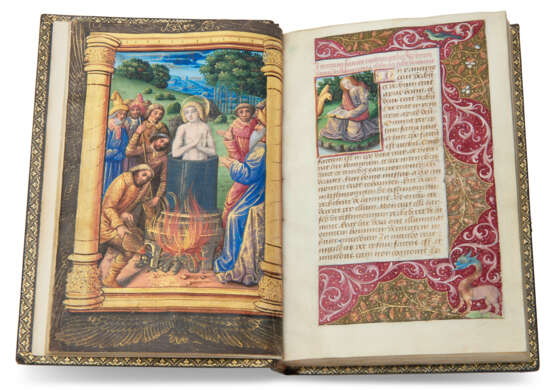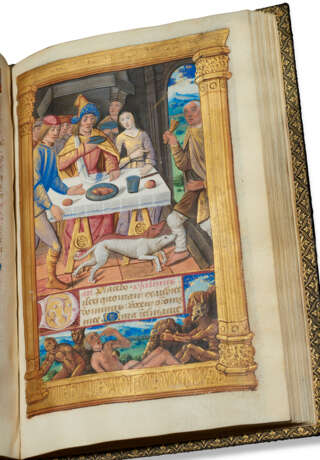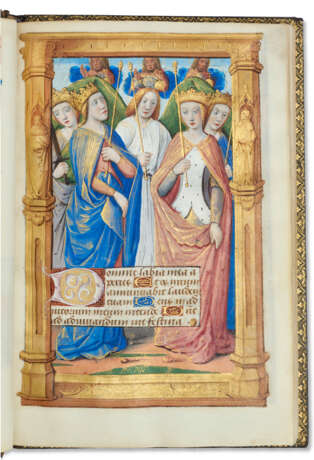ID 990547
Lot 13 | Master of Martainville 183 (active late 15th/early 16th century)
Valeur estimée
£ 300 000 – 500 000
Book of Hours, use of Rome, in Latin and French, illuminated manuscript on vellum [Paris, c.1490s]
A lavishly illuminated, iconographically unusual manuscript in the finest hand of the Martainville Master, once in the collections of Napoleon’s chamberlain Count Joseph-François de Kergariou, and later the great French bibliophile André Hachette.
170 x 115mm. iii (paper) + 96 leaves + i + iv (paper), complete, collation: 16, 28, 36, 48, 54, 68, 74, 8-128, 134, partial catchwords survive, 27 lines of text, ruled space: 104 x 61mm, rubrics in red, illuminated initials and line-fillers throughout, 13 full-page miniatures within architectural frames, 10 of which incorporating bas-de-page scenes, one very large miniature within a three-sided border, 18 smaller miniatures within three-sided borders, 42 calendar miniatures with occupations of the month, zodiac signs, saints and biblical scenes, every text page with three-sided borders incorporating floral and geometric designs and inhabited by birds, insects, animals, fruits and grotesques (a few occasional tiny losses of pigment, e.g. to St John’s robes on f.7, but generally in excellent condition). Bound in 19th-century French morocco tooled in blind and gilt-stamped with the arms and motto of Count Joseph-François de Kergariou (a little rubbed). Fitted box.
Provenance:
(1) Erased 17th?-century inscription in a French? hand on f.2, almost illegible but ‘[…]SE DAMS […]tables’ visible under black light.
(2) Count Joseph-François de Kergariou (1779-1849), French bibliophile, pioneer of Breton numismatics, prefect of Indre-et-Loire, and Napoleon's chamberlain; his stamped armorial binding with coat of arms and motto ‘La ou ailleurs’, and blue library label to lower inner cover ‘L 161’.
(3) André Hachette (1873–1952); with his ink-stamp (Lugt no 132) and booklabel with ‘30’ in the corner; his sale, Collection André Hachette: manuscrits du XIIe au XVIe sie'cle […], Librairie Giraud-Badin, Paris, 16 December 1953, lot 19 (ill.).
(4) Paris: Ader Picard Tajan, 21 June 1985, lot 8, and subsequently Heribert Tenschert, Leuchtendes Mittelalter III, catalogue 45, 2000, where acquired.
Content:
Blanks ff.1-3; Calendar ff.3v-6; Gospel extracts ff.7-10; Obsecro te and O intemerata ff.10-13v; Hours of the Virgin, use of Rome, ff.14-52v: matins f.14, lauds f.24, prime f.30v, terce f.33v, sext f.36, none f.38v, vespers f.41v, compline f.46; Seven Penitential Psalms and Litany ff.53-63v; Hours of the Cross ff.64-65v; Hours of the Holy Spirit ff.66-67v; Office of the Dead, use of Rome, ff.68-91v; Suffrages ff.92-96v.
Illumination:
The richly iconographic programme of illumination fits into the small group of extensively decorated Parisian Hours with historiated borders and bas-de-page scenes associated with the Master of Martainville 183, an artist greatly indebted to Jean Pichore and Jean Bourdichon and named from a Book of Hours in the Bibliothèque municipale in Rouen (on these, see I. Delaunay in Revue du Louvre, no 4, 1993, pp.11-15 and M. Hofmann, ‘Meister von Martainville 183’, in Allgemeines Künstlerlexikon, 2015). Such is the quality and refinement of the miniatures in the present Hours that they must be the hand of the Master himself, and certainly comparable to the Martainville Hours themselves, the ‘Libro de Horas de Carlo V’ (Madrid, Biblioteca Nacional, Vitr. 24.3), a Book of Hours in San Marino (Huntington Library HM 1250) and one in London (British Library, Harley 2936) (see C. Zöhl, Jean Pichore, Buchmaler, Graphiker und Verlegerin Paris um 1500, 2004, especially pp.46-7). There are close similarities, in terms of the intricate ornament of the borders and rich colours and skilful detailing of the miniatures, to British Library Add. MS. 25696 (see for example the mis-en-scène of the Adoration of the Shepherds on f.17v, and compare it to the treatment of the Virgin – with her chalk-white complexion, oval face, and gold striations in her auburn hair – and especially the Child – with its plumply delineated joints and belly – on f.30v of our manuscript), and to a Book of Hours in Chantilly, Bibliothèque et Archives du Château, Ms. 72 (see in particular the Presentation in the Temple in that manuscript on f.21v and compare to the corresponding miniature on f.38v: we find an almost identical compositional layout, with the folds of the Virgin’s cloak gathering around the foot of the altar, a scene identically replicated in Morgan Library MS. M. 7, f.24v).
The manuscript delights for its unusual iconographic choices: instead of an Annunciation, the full-page miniature opening matins for the Hours of the Virgin shows the virtues Justice, Peace, Mercy and Truth reconciled in Heaven through the event of the Incarnation. The scene is based on the Mystery Play by Arnoul Gréban, a contemporary of the prolific Parisian artist Maître François (or François le Berbier père) who was responsible for developing this particular composition and relating it to the canonical Hour of matins. It appears most magnificently in the Wharncliffe Hours (Melbourne, National Gallery of Victoria, Felton Bequest, 1920) and then in a small number of manuscripts executed by him from the early 1470s onwards, including a tiny Book of Hours in the British Library, Egerton MS. 2045. A strikingly similar composition also appears in a Book of Hours of c.1490, tentatively attributed to a follower of Bourdichon and Poyet, and then later to the Martainville Master, which was sold at Christie’s on 4 June 2003, lot 20.
The miniature opening the Hours of the Cross is another rare iconographic choice: it depicts Christ sitting not on the cold stone (as he is sometimes represented awaiting his crucifixion), but on the Cross itself, which is propped up on a stone while two soldiers drill holes for the nails. Also interesting is the bas-de-page scene beneath the miniature with Pentecost (f.66), which shows ‘doubting’ St Thomas receiving the Virgin’s girdle from an angel as proof of her Assumption (Pentecost was the last appearance of the Virgin Mary before her Dormition and Assumption).
The subjects of the large/full-page miniatures are as follows: John the Evangelist being boiled in oil f.6v; The Meeting at the Golden Gate, within a three-sided border f.13v; The Parliament of Heaven with the Trinity above Gabriel, who will be sent to announce the Incarnation that will bring about the salvation of mankind, and the Virtues, who have been disputing mankind's fate: Mercy and Truth on the right, Justice and Peace on the left f.14; the Visitation f.24; the Nativity f.30v; Annunciation to the Shepherds, with a bas-de-page scene showing shepherds looking out over an evening landscape f.33v; Adoration of the Magi, with a bas-de-page scene showing a camel and the Magi’s retinue set against a similar evening landscape f.36; the Presentation in the Temple, with a bas-de-page scene depicting a crowd looking over a similar evening landscape f.38v; Massacre of the Innocents, with a bas-de-page scene depicting the Flight into Egypt f.41v; the Dormition of the Virgin, with a bas-de-page scene depicting the Coronation of the Virgin f.46; the Last Judgement, with a bas-de-page scene depicting souls being prodded by demons into the Hellmouth f.53; Christ waiting to be crucified, while soldiers bore holes in the Cross, with a bas-de-page scene depicting Christ carrying the Cross f.64; Pentecost, with a bas-de-page scene depicting St Thomas receiving the Virgin’s girdle from an angel f.66; Dives and Lazarus at the banquet, with a bas-de-page scene depicting Dives being tormented in hell f.68.
The subjects of the smaller miniatures are as follows: John on Patmos f.7; Luke f.8; Matthew f.8v; Mark f.9v; the Holy Family f.10; Pietà f.12; the Holy Trinity f.92; St Michael f.92v; St John the Baptist f.92v; Sts Peter and Paul f.93; St James f.93v; St Stephen f.94; St Sebastian f.94; St Anthony Abbot f.94v; Mary Magdalene f.95; St Catherine f.95v; St Anna f.96; St Barbara f.96v.
Special notice
No VAT on hammer price or buyer's premium.
| Lieu d'origine: | Europe de l'Ouest, France, Europe |
|---|---|
| Catégorie maison de vente aux enchères: | Manuscrits médiévaux et de la Renaissance |
| Lieu d'origine: | Europe de l'Ouest, France, Europe |
|---|---|
| Catégorie maison de vente aux enchères: | Manuscrits médiévaux et de la Renaissance |
| Adresse de l'enchère |
CHRISTIE'S 8 King Street, St. James's SW1Y 6QT London Royaume-Uni | |
|---|---|---|
| Aperçu |
| |
| Téléphone | +44 (0)20 7839 9060 | |
| Commission | see on Website | |
| Conditions d'utilisation | Conditions d'utilisation |












